CBSE Class 12 Chemistry Chapter-7 Important Questions - Free PDF Download
Free PDF download of Important Questions for CBSE Class 12 Chemistry Chapter 7 - Alcohols, Phenols, and Ethers prepared by expert Chemistry teachers from the latest edition of CBSE (NCERT) books. Register online for Chemistry tuition on Vedantu.com to score more marks in the CBSE board examination.
Important Questions for CBSE Class 12 Chemistry Chapter 7 - Topics Covered
Following are the topics that are covered in this chapter:
Classification
Nomenclature
Structures of Functional Groups
Alcohols and Phenols
Some Commercially Important Alcohols
Ethers
Study Important Questions for class 12 Chemistry Chapter 7 – Alcohols, phenols and Ethers
Q1. Write IUPAC names of the following compounds:
(i)

3-chloromethyl-2-isopropyl pentan-1-ol
Ans. 3-chloromethyl-2-isopropyl pentan-1-ol
(ii)

3-bromo cyclohexan-1-ol
Ans. 3-bromo cyclohexan-1-ol
(iii) ${\text{CH}} \equiv {\text{C}} - {\text{C}}{{\text{H}}_2}{\text{OH}}$
Ans. Prop-2-yn-1-ol
(iv)

1-phenyl Ethan-1-ol
Ans. 1-phenyl Ethan-1-ol
(v)

3-benzyl prop-2-en-1-ol
Ans. 3-benyl prop-2-en-1-ol
(vi)

Benzene-1,3-diol
Ans. Benzene-1,3-diol
(vii)

4-bromo-3-cyano phenol
Ans. 4-bromo-3-cyano phenol
(viii)

2-nitro ethoxybenzene
Ans. 2-nitro ethoxybenzene
(ix) ${{\text{C}}_6}{{\text{H}}_5}{\text{O}}{{\text{C}}_3}{{\text{H}}_7}$
Ans. Propoxybenzene
(x)${\text{C}}{{\text{H}}_3}{\text{C}}{{\text{H}}_2}{\text{OC}}{{\text{H}}_2}{\text{C}}{{\text{H}}_2}{\text{C}}{{\text{H}}_2}{\text{Cl}}$
Ans. 3-ethoxy chloropropane
Q2. Write the structures of the compounds whose names are given below:
(i) 3,5 -dimethoxyhexane-1,3,5-triol
Ans.

3,5 -dimethoxyhexane-1,3,5-triol
(ii) cyclohexylmethanol
Ans.

Cyclohexylmethanol
(iii) 2-ethoxy-3-methylpentane
Ans.

2-ethoxy-3-methylpentane
(iv) 3 -chloromethylpentan-2-ol
Ans.
(image will be uploaded soon)
(v) p-nitroanisole
Ans.
(image will be uploaded soon)
Q3. Describe the following reactions with example:
(i) Hydroboration oxidation of alkenes
Ans. The hydroboration-oxidation route is a two-step process for producing alcohols. The reaction proceeds in an Anti-Markovnikov fashion, with the hydrogen (from ${\text{B}}{{\text{H}}_{\text{3}}}$ or ${\text{BH}}{{\text{R}}_{\text{2}}}$) attaching to the most substituted carbon in the alkene double bond and the boron attaching to the least substituted carbon.

Hydroboration oxidation of alkenes
(ii) Acid catalysed dehydration of alcohols at $443\;{\text{K}}$.
Ans. The following reaction shows the acid dehydration of ethanol to produce ethene.
The protonation of the oxygen atom in the OH group is the first step. The second step is the loss of a water molecule, which results in the formation of the carbonium ion. The final step is deprotonation, which results in the formation of a carbon-carbon double bond.

Acid catalysed dehydration of ethanol
(iii) Williamson synthesis
Ans. The Williamson ether synthesis method involves permitting alkyl group halides to react with sodium alkoxides within the workplace to yield symmetrical and unsymmetrical ethers. This reaction includes the alkoxide particle offensive the organic compound via ${\text{S}}{{\text{N}}^2}$mechanism. within the case of primary alkyl group halides, higher results are obtained. If the organic compound is secondary or tertiary, substitution prioritises over elimination.

Williamson synthesis
(iv) Reimer-Tiemann reaction.
Ans. The ${\text{ - CHO}}$ group is introduced at the ortho position of the benzene ring when phenol is treated with chloroform in the presence of sodium hydroxide.

Reimer-Tiemann reaction
The Reimer-Tiemann reaction is the name for this reaction. In the presence of alkalis, the intermediate is hydrolyzed to create salicylaldehyde.

Reimer-Tiemann reaction
(v) Kolbe's reaction
Ans. Kolbe’s reaction: Salicylic acid is made by boiling a combination of sodium phenoxide and carbon dioxide at ${\text{180 - 20}}{{\text{0}}^{\text{o}}}{\text{c}}$ under pressure.

Kolbe’s Reaction
(vi) Friedel-Crafts acylation of Anisole.
Ans. The aromatic ring is converted into an aryl ketone via a Friedel-Crafts acylation process. Anisole interacts with acetyl chloride; it transforms into ketone.

Friedel-Crafts acylation of Anisole
Q4. Complete the following reactions:
(i) ${\text{C}}{{\text{H}}_{\text{3}}}{\text{C}}{{\text{H}}_{\text{2}}}{\text{C}}{{\text{H}}_{\text{2}}}{\text{CHO}}\xrightarrow{{{\text{Pd/}}{{\text{H}}_{\text{2}}}}}$
Ans:

Butanal to Butanol
(ii)

Reaction of ethanal with Grignard’s reagent and further hydrolysed
Ans.

Complete reaction of ethanal with Grignard’s reagent and further hydrolysed to give 1-methyl ethan-1-ol.
(iii)

Reaction of ethanol in the presence of Copper at 573K
Ans.

Complete reaction of ethanol in the presence of Copper at 573K
(iv) ${{\text{C}}_{\text{6}}}{{\text{H}}_{\text{5}}}{\text{OH + B}}{{\text{r}}_{\text{2}}}\xrightarrow{{{{\text{H}}_{\text{2}}}{\text{O}}}}$
Ans.

Complete reaction of phenol with 3 moles of bromine.
(v)
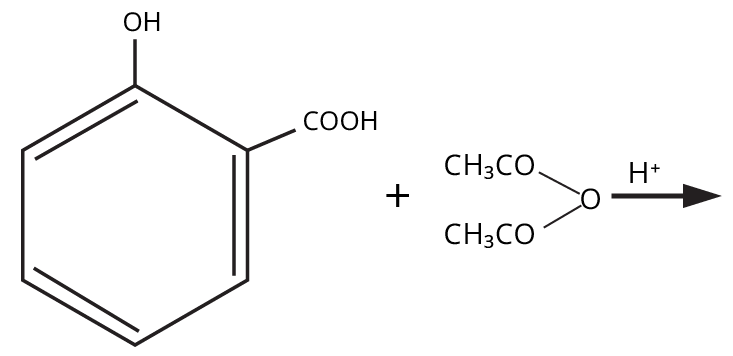
Reaction of salicylic acid with acetic anhydride
Ans.

Complete reaction of salicylic acid with acetic anhydride
(vi)

Reaction of sodium salt of substituted phenol with methylbromide
Ans.

Complete reaction of sodium salt of substituted phenol with methylbromide
(vii)${\text{C}}{{\text{H}}_3}{\text{C}}{{\text{H}}_2}{\text{C}}{{\text{H}}_2}{\text{O}} - {\text{C}}{{\text{H}}_3} + {\text{HBr}}\xrightarrow{{}}$
Ans.

Complete reaction of methoxy proprane with Hydrogen bromide.
(viii)

Reaction of Ethoxy benzene with Hydrogen bromide.
Ans.
(image will be uploaded soon)
(ix) ${\left( {{\text{C}}{{\text{H}}_3}} \right)_3}{\text{C}} - {\text{O}} - {{\text{C}}_2}{{\text{H}}_5} + {\text{HI}}\xrightarrow{{}}$
Ans.

Complete reaction of Tertiary butyl ethyl ether with Hydrogen Iodide.
(x)

Reaction of Methoxy benzene with conc. Nitric acid in the presence of conc. Sulphuric acid.
Ans.
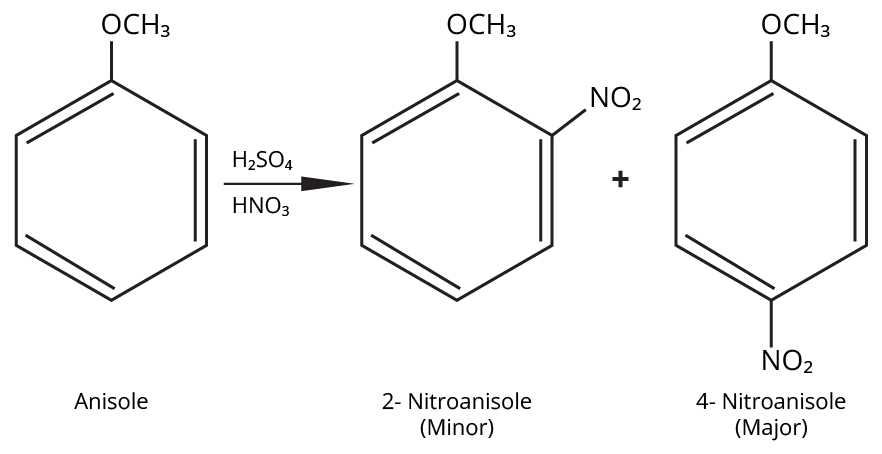
Reaction of Anisole with Nitric acid in the presence of Sulphuric acid.
(xi)

Reaction of given cyclic organic compound with Sodium Borohydride
(xii)

Reaction of given Acyclic organic compound with Sodium Borohydride
Ans. CH3CH2CHCHO→CH3CH2CHCH2OH
(xiii)

Reaction of benzene sulphonic acid with Sodium hydroxide in the presence of heat and further fused.
Ans.

Complete reaction of benzene sulphonic acid with Sodium hydroxide in the presence of heat and further fused.
Q5. What happens when:
(i) aluminium reacts with tert-butyl alcohol
Ans.
Complete reaction of Ethoxy benzene with Hydrogen bromide
(ii) phenol is oxidised with chromic acid
Ans.
Complete reaction of Ethoxy benzene with Hydrogen bromide
(iii) cumene is oxidised in the presence of air and the product formed is treated with dilute acid.
Ans.

Complete reaction of Cumene with oxygen.
(iv) phenol is treated with conc. ${\text{HN}}{{\text{O}}_3}$.
Ans.

Complete reaction of Phenol with Nitric acid.
(v) phenol is treated with chloroform in presence of dilute ${\text{NaOH}}$.
Ans.

Complete reaction of Phenol with Chloroform in the presence of sodium hydroxide.
Q6. How will you convert
(i) propene to propan-1-ol.
Ans.

Complete reaction of Alkene with sulphuric acid and water.
(ii) anisole to phenol
Ans.
Complete reaction of Anisole with Hydrogen Iodide to yield phenol
(iii) butan-2-one to butan-2-ol
Ans.

Conversion of butan-2-one to bhutan-2-ol.
(iv) ethanal to ethanol
Ans.

Conversion of ethanal to ethanol.
(v) phenol to ethoxybenzene
Ans.

Conversion of phenol to ethoxybenzene
(vi) 1-phenylethene to 1-phenylethanol
Ans.

Conversion of 1-phenylethene to 1-phenylethanol
(vii) formaldehyde to cyclohexylmethanol
Ans.

Conversion of formaldehyde to cyclohexylmethanol
(viii) butyl bromide to pentan-1-ol.
Ans.

Butyl Bromide to Pentan-1-ol.
(ix) toluene to benzyl alcohol
Ans.

Conversion of toluene to benzyl alcohol
(x) 1-propoxypropane to propyl iodide
Ans.

Conversion of 1-propoxypropane to propyl iodide
(xi) ethyl bromide to 1-ethoxyethane
Ans. ${\text{C}}{{\text{H}}_{\text{3}}}{\text{C}}{{\text{H}}_{\text{2}}}{\text{Br + N}}{{\text{a}}^{\text{ + }}}{{\text{O}}^{\text{ - }}}{{\text{C}}_{\text{2}}}{{\text{H}}_{\text{5}}}\xrightarrow{\Delta }{\text{C}}{{\text{H}}_{\text{3}}}{\text{C}}{{\text{H}}_{\text{2}}} - {\text{O}} - {{\text{C}}_{\text{2}}}{{\text{H}}_{\text{5}}}{\text{ + NaBr}}$
(xii) methyl bromide to 2-methoxy-2-methylpropane
Ans.

methyl bromide to 2-methoxy-2-methylpropane
(xiii) ethyl bromide to ethoxybenzene
Ans.

Ethyl Bromide to Ethoxybenzene
(xiv) ethanol to benzyl ethyl ether.
Ans.

Ethanol to Benzyl Ethyl Ether
Q7. Identify the missing reactant or product A to ${\text{D}}$ in the following equations:
(i)

Reaction of Compound A with nitric acid and sulphuric acid.
Ans. The compound A is phenol.

Compound A formed is Phenol.
(ii)

Reaction of 1-methyl cyclohexene with dilute sulphuric acid to give rise to a compound B.
Ans. The compound B is 1-methyl cyclohexanol.

Compound B formed is 1-methyl cyclohexanol.
(iii) ${\text{(C) + }}{{\text{H}}_{\text{2}}}{\text{O }}\xrightarrow{{{{\text{H}}^{\text{ + }}}}}{\text{ C}}{{\text{H}}_{\text{3}}}{\left( {{\text{C}}{{\text{H}}_{\text{2}}}} \right)_{\text{2}}}{\text{C}}\left( {{\text{C}}{{\text{H}}_{\text{3}}}} \right){\text{(OH)}}{\left( {{\text{C}}{{\text{H}}_{\text{2}}}} \right)_{\text{2}}}{\text{C}}{{\text{H}}_{\text{3}}}$
The compound C is 2-propyl propan-2-one.
${\text{C}}{{\text{H}}_{\text{3}}}{\left( {{\text{C}}{{\text{H}}_{\text{2}}}} \right)_{\text{2}}}{\text{CO}}\left( {{\text{C}}{{\text{H}}_{\text{3}}}} \right){\left( {{\text{C}}{{\text{H}}_{\text{2}}}} \right)_{\text{2}}}{\text{C}}{{\text{H}}_{\text{3}}}$
(vi) ${\text{C}}{{\text{H}}_3}{\text{O}}{{\text{C}}_6}{{\text{H}}_5} + {\text{HI}}\xrightarrow{{}}{\text{ (D)}}$
Ans. The compound D are phenol and methyl iodide.
${{\text{C}}_{\text{6}}}{{\text{H}}_{\text{5}}}{\text{ + C}}{{\text{H}}_{\text{3}}}{\text{ - I}}$
Q8. Identify ${\text{X}},{\text{Y}}$ and ${\text{Z}}$ in the following sequence of reactions:
(i) ${\text{Phenol}}\xrightarrow{{{\text{Zn dust}}}}{\text{ X}}\xrightarrow[{{\text{Anhy}}{\text{. AlC}}{{\text{l}}_{\text{3}}}}]{{{\text{C}}{{\text{H}}_{\text{3}}}{\text{Cl}}}}{\text{ Y }}\xrightarrow[{{\text{O}}{{\text{H}}^{\text{ - }}}}]{{{\text{KMn}}{{\text{O}}_{\text{4}}}}}{\text{ Z}}$
Ans.
(image will be uploaded soon)
X is Benzene.
Y is Toluene.
Z is benzoic acid.
(ii) ${\text{Ethanol}}\xrightarrow{{{\text{PB}}{{\text{r}}_{\text{3}}}}}{\text{ X}}\xrightarrow[{}]{{{\text{alc}}{\text{.KOH}}}}{\text{ Y }}\xrightarrow[{}]{{{\text{dil}}{\text{.}}{{\text{H}}_{\text{2}}}{\text{S}}{{\text{O}}_{\text{4}}}}}{\text{ Z}}$
Ans.

Showing formation of Ethyl bromide(X), Ethene(Y), Ethanol(Z)
X is Ethyl bromide.
Y is Ethene.
Z is Ethanol.
(iii)

Reaction of 3 methyl anisole with Hydrogen iodide.
Ans. The compound X is 3-methyl phenol.
(image will be uploaded soon)
\[{\text{X}} + {\text{conc}}.{\text{HN}}{{\text{O}}_3}\xrightarrow{{}}{\text{Y (a dinitro compound) }}\]
Ans. The compound Y is 2,4-Dinitro-5-methylphenol.
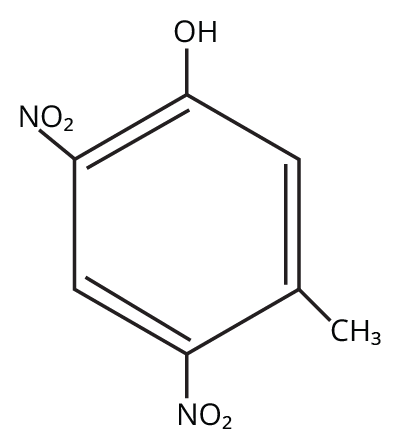
2,4-Dinitro-5-methylphenol
${\text{X}} + {\text{B}}{{\text{r}}_2}({\text{aq}})\xrightarrow{{}}{\text{Z (a tribromo product) }}$
Ans. The compound Z is 2,4,6-Tribromo-3-methylphenol.

Compound Z formed is 2,4,6-Tribromo-3-methylphenol.
Q10. write the mechanism for the following reactions:

Reaction showing acid catalysed hydration of alkenes
Ans.

Mechanism showing acid catalysed hydration of alkenes
(ii) ${\text{C}}{{\text{H}}_{\text{3}}}{\text{ - C}}{{\text{H}}_{\text{2}}}{\text{ - OH}}\xrightarrow[{{\text{443K}}}]{{{{\text{H}}^{\text{ + }}}}}{\text{C}}{{\text{H}}_{\text{2}}}{\text{ = C}}{{\text{H}}_{\text{2}}}$
(acid catalysed dehydration of alcohols)
Ans.

Mechanism showing acid catalysed dehydration of alcohols
(iii) $2{\text{C}}{{\text{H}}_3}{\text{C}}{{\text{H}}_2}{\text{OH}}\xrightarrow[{{\text{443K}}}]{{{{\text{H}}^{\text{ + }}}}}{\text{C}}{{\text{H}}_3}{\text{C}}{{\text{H}}_2}{\text{OC}}{{\text{H}}_2}{\text{C}}{{\text{H}}_3}$
(acid catalysed nucleophilic substitution reaction)
Ans.

Mechanism showing acid catalysed nucleophilic substitution reaction
(iv) ${\text{C}}{{\text{H}}_3}{\text{OC}}{{\text{H}}_3} + {\text{Hl}}\xrightarrow{{}}{\text{C}}{{\text{H}}_3}{\text{OH}} + {\text{C}}{{\text{H}}_3}{\text{I}}$
Ans.

Mechanism showing reaction of alcohol with hydrogen bromide to give rise to alkyl halide
Where R is the methyl group and ${\text{HI}}$ is the halogen acid.
(v) ${\left( {{\text{C}}{{\text{H}}_3}} \right)_3}{\text{C}} - {\text{O}} - {\text{C}}{{\text{H}}_3} + {\text{Hl}}\xrightarrow{{}}{\text{C}}{{\text{H}}_3}{\text{OH}} + {\left( {{\text{C}}{{\text{H}}_3}} \right)_3}{\text{Cl}}$
Ans.

Mechanism showing reaction of ether with hydrogen iodide to give rise to tert-butyl iodide
Q11. Give reason for the following:
(i) The ${\text{C - O - C}}$bond angle in dimethyl ether is $111.7{}^\circ $
Ans. The two lone pairs of electrons in oxygen try to get closer to the oxygen atom in this molecule. The repulsion of lone pairs of electrons cannot compress the side groups, however, since they are hefty. As a result, the bond angle will be $111.7{}^\circ $.
(ii) Alcohols have higher boiling points than ethers of comparable molecular masses.
Ans. Because the ${\text{OH}}$ group permits alcohol molecules to form hydrogen bonds, they have higher boiling temperatures than ethers and alkanes with similar molar weights.
(iii) Phenols are more acidic than alcohols.
Ans. Although phenols are more powerful than alcohols, they are still rather weak acids. Because the phenoxide ion is more persistent than the alkoxide ion, phenol is more acidic than cyclohexanol and acyclic alcohols. The negative charge of an alkoxide ion, such as the one formed from cyclohexanol, is concentrated near the oxygen atom.
(iv) Nitrophenol is more acidic than o-methoxyphenol.
Ans. The acidity of ortho-nitrophenol is higher than that of ortho-methoxyphenol. The presence of the nitro group in the ortho position, which is an electron withdrawing group, reduces the electron density in the ${\text{O - H}}$ bond. Due to resonance, the o-nitrophenoxide ion produced following the loss of protons is also stable.
(v) Phenol is more reactive towards electrophilic substitution reaction than benzene.
Ans. When it comes to electrophilic substitution reactions, phenol is more reactive than benzene. The electron density around the ring system is increased by the donation of the oxygen's lone pair into the ring system. In comparison to benzene, this makes the ring significantly more reactive. The intermediate carbocation is more stable in terms of resonance.
(vii) The following is not an appropriate method for the preparation of t-butyl ethyl ether:

Reaction of sodium ethoxide with hydrogen iodide to give rise to tert-butyl chloride.
(a) What would be the major product of this reaction?
Ans. The major product in the above reaction is t-butyl ethyl ether
(b) Write suitable reaction for the preparation of t-butyl ethyl ether.
Ans. t-butyl ethyl ether can be prepared as follows:

Reaction of sodium tertiary butoxide with hydrogen iodide to give rise to tert-butyl ethyl ether.
(viii) The following is not an appropriate method for the preparation of 1-methoxy-4-nitrobenzene;

Reaction of 4-bromo nitrobenzene with sodium methoxide to give rise to 4-nitro anisole.
(x) Write the suitable reaction for the preparation of 1-methoxy-4-nitrobenzene
Ans.
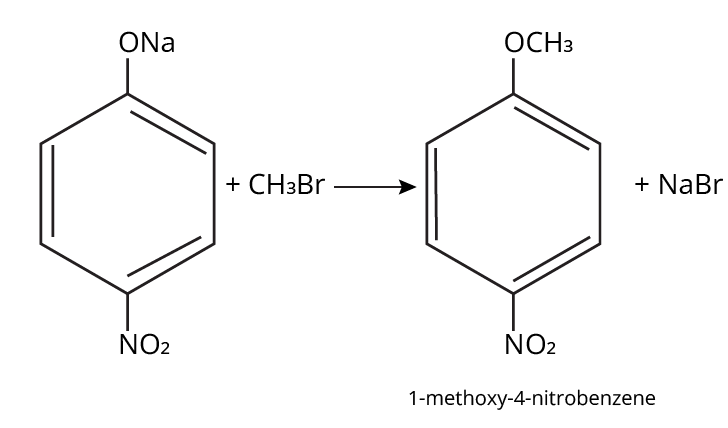
Reaction showing the formation of 1-methoxy-4-nitrobenzene
(ix) o-nitrophenol is steam volatile but p-nitrophenol is not.
Ans. In the case of p-nitrophenol molecules, energy is necessary to overcome attractive forces, while in the case of o-nitrophenol molecules, no such energy is required. This indicates that o-nitrophenol has a lower boiling point and is thus steam volatile, whereas p-nitrophenol has a higher boiling point and is thus steam non-volatile.
(x) phenol is less polar than ethanol.
Ans. The polarity of phenol is higher than that of ethanol. The phenol ${\text{O - H}}$ bond is more polar than the ethanol ${\text{O - H}}$ bond. The electron pair at ${\text{O}}$ in phenol travels towards the conjugated benzene ring and demonstrates resonance. The polarity of the ${\text{O - H}}$ bond rises as a result of this resonance.
(xi) The phenyl methyl ether reacts with ${\text{HI}}$ to form phenol and iodomethane and not iodobenzene and methanol.
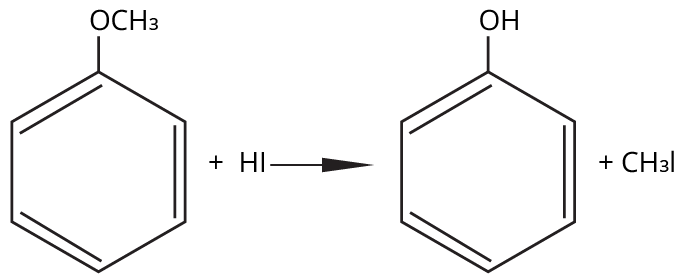
Reaction showing the formation of phenol from anisole
Ans. Because HI is a powerful acid; hydrogen ions are easily produced. As oxygen contains lone pairs, this produced hydrogen ion attacks the oxygen atom of phenyl methyl ether. When oxygen makes three bonds and has a positive charge, it becomes unstable. As a result, nucleophilic addition occurs. Because the charge on the methyl group is unstable, and there is a resonance between oxygen and the benzene ring, it undergoes the ${\text{S}}{{\text{N}}_{\text{2}}}$ process. There will be a transition state when the methyl group's carbon atom has 5 bonds when it is attacked by a nucleophile. As iodine ions are big, and the benzene ring is even bigger than the methyl group. There will be a lot of steric repulsions if the iodine and benzene groups approach each other. Phenol and methyl iodide are produced as a result.
(xii) methanol is less acidic than water.
Ans. Water is significantly less acidic in the gas phase than methanol, which is consistent with the polarizability differential between a proton and a methyl group. Water is more acidic than methanol because the solvation energy of hydroxide is even higher than that of methoxide.
(xiii) alcohols can act as weak base as well as weak acids.
Ans. Alcohol is amphoteric, meaning it can function as both an acid and a base. Alcohol is a base because it can receive ${{\text{H}}^{\text{ + }}}$ from both mineral acids and water. Due to the existence of the strong conjugate base ${\text{R}}{{\text{O}}^{\text{ - }}}$, it functions as a weak acid. The acid becomes weaker as the conjugate base becomes stronger.
(xiv) phenols do not give protonation reaction readily.
Ans. Protonation is difficult to achieve using phenol. Through resonance, the lone pair on oxygen ${\text{O}} - {\text{H}}$ in phenol is shared with the benzene ring. As a result, phenols do not undergo protonation reactions because a lone pair is not entirely present on oxygen.
(xvi) absolute ethanol cannot be obtained by factional distillation of ethanol and water mixture.
Ans. Fractional distillation cannot separate absolute alcohol. The process of fractional distillation is when a liquid mixture is vaporised, resulting in a mixture of components from which the desired component is separated into pure form.
Q12. Arrange the following in the increasing order of property shown:
(i) methanol, ethanol, diethylether, ethyleneglycol. (Boiling points)
Ans. ${\text{diethyl ether < methanol < ethanol < ethylene glycol}}$
(ii) phenol, o-nitrophenol, m-nitrophenol, p-nitrophenol. (Acid strength)
Ans. \[{\text{phenol}} < {\text{ m - nitrophenol < o - nitrophenol < p - nitrophenol}}\]
(iii) dimethylether, ethanol, phenol. (Solubility in water)
Ans. ${\text{dimethyl ether < phenol < ethanol}}$
(iv) n-butanol, 2-methylpropan-1-ol, 2-methylpropan-2-ol. (Acid strength)
Ans. \[{\text{n - butanol < 2 - methylpropan - 1 - ol < 2 - methylpropan - 2 - ol}}\]
Q13. Give a chemical test to distinguish between the following pair of compounds.
(i) n-propyl alcohol and isopropylalcohol
Ans. Lucas test can be used to distinguish n-propyl alcohol and isopropylalcohol.
(image will be uploaded soon)
(ii) methanol and ethanol
Ans. Iodoform test can be done to distinguish between methanol and ethanol.
(image will be uploaded soon)
(iii) cyclohexanol and phenol.
Ans. With a neutral ${\text{FeC}}{{\text{l}}_{\text{3}}}$ solution, phenol becomes violet, but Cyclohexanol does not.

Chemical test to distingush cyclohexanol and phenol
(iv) propan-2-ol and 2-methylpropan-2-ol.
Ans. propan-2-ol and 2-methylpropan-2-ol can be distinguished with process of copper metal which is as follows:
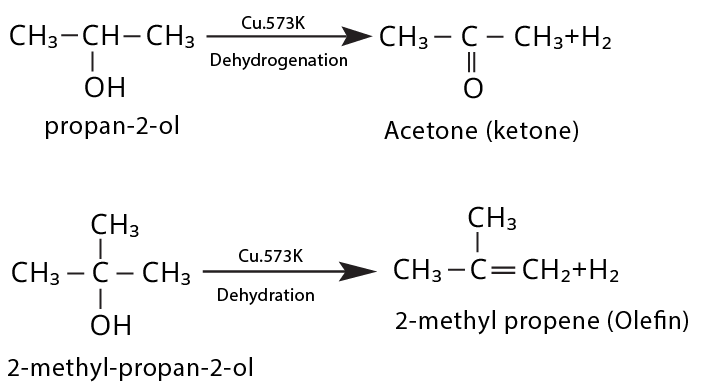
Chemical test to distingush propan-2-ol and 2-methylpropan-2-ol.
(v) phenol and anisole
Ans. ${\text{FeC}}{{\text{l}}_{\text{3}}}$test can be used to distinguish between phenol and anisole.

Chemical test to distingush phenol and anisole.
The ferric phenoxide formed is violet in color.

Ferric phenoxide showing no characteristic change
(vi) ethanol and diethyl ether
Ans. ethanol and diethyl ether can be distinguished by iodoform test.
(image will be uploaded soon)
Diethyl ether does not give iodoform test (No Reaction)
Q14. Which of the following compounds gives fastest reaction with ${\text{HBr}}$ and why?
(i) ${\left( {{\text{C}}{{\text{H}}_3}} \right)_3}{\text{COH}}$
(ii) ${\text{C}}{{\text{H}}_3}{\text{C}}{{\text{H}}_2}{\text{C}}{{\text{H}}_2}{\text{OH}}$

(iii)

(iv)
Ans. Out of all the given compounds (i) i.e. tertiary alcohol will give fastest reaction with ${\text{HBr}}$.
The increased number of alkyl groups in tertiary alcohols increases the ${\text{ + I}}$ effect, making them more reactive. As a result, the charge density on carbon atoms increases, as does the charge density around oxygen atoms. The lone pairs on oxygen atoms are being pushed away by this negative charge density. Therefore, compound (i) t-butyl alcohol is most reactive towards ${\text{HBr}}$.
Q15. What is the function of ${\text{ZnC}}{{\text{l}}_2}$ (anhydrous) in Lucas test for distinction between $1{}^\circ ,2{}^\circ $ and $3{}^\circ $ alcohols.
Ans. Lucas Reagent is\[\left( {{\text{ZnC}}{{\text{l}}_{\text{2}}}{\text{ + HCl}}} \right)\] Because of \[{\text{Zn}}\] has vacant d orbitals, \[{\text{ZnC}}{{\text{l}}_{\text{2}}}\] is a Lewis acid. The oxygen in ${\text{ - OH}}$ forms a coordination connection with Zinc, or compounds with it. Oxygen takes on a positive charge, whereas \[{\text{Zn}}\]takes on a negative charge. So, because oxygen now has a positive charge, a poor leaving group ${\text{ - OH}}$has been transformed into a good leaving group (increased electronegativity).
Q16. An alcohol A $\left( {{{\text{C}}_4}{{\text{H}}_{10}}{\text{O}}} \right)$ on oxidation with acidified potassium dichromate gives carboxylic acid ${\text{B}}\left( {{{\text{C}}_4}{{\text{H}}_8}{{\text{O}}_2}} \right)$. Compound ${\text{A}}$ when dehydrated with conc. ${{\text{H}}_2}{\text{S}}{{\text{O}}_4}$ at $443\;{\text{K}}$ gives compound ${\text{C}}$. Treatment of ${\text{C}}$ with aqueous ${{\text{H}}_2}{\text{S}}{{\text{O}}_4}$ gives compound ${\text{D}}\left( {{{\text{C}}_4}{{\text{H}}_{10}}{\text{O}}} \right)$ which is an isomer of ${\text{A}}$. Compound D is resistant to oxidation but compound A can be easily oxidised. Identify ${\text{A}},{\text{B}},{\text{C}}$ and ${\text{D}}$ and write their structures.
Ans. The compound A i.e. ${{\text{C}}_4}{{\text{H}}_{10}}{\text{O}}$ corresponds to 2-methyl propan-1-ol, which is a primary alcohol. When A undergoes oxidation, the alcohol gets converted to corresponding carboxylic acid. The carboxylic acid B formed is 2-methyl propan-1-oic acid. On further dehydration, B forms double bonded compound C i.e. 2-methyl prop-1-ene. The alkene formed reacts with aqueous ${{\text{H}}_2}{\text{S}}{{\text{O}}_4}$ to again form an alcohol compound called, 2-methyl propan-2-ol which is D and is an isomer of A.

An alcohol when treated with various reagents leads to the formation of compounds A,B,C and D respectively.
Q17. An organic compound A having molecular formula ${{\text{C}}_6}{{\text{H}}_6}{\text{O}}$ gives a characteristic colour with aqueous ${\text{FeC}}{{\text{l}}_3}$. When ${\text{A}}$ is treated with ${\text{NaOH}}$ and ${\text{C}}{{\text{O}}_2}$ at $400\;{\text{K}}$ under pressure, compound ${\text{B}}$ is obtained. Compound B on acidification gives compound $C$ which reacts with acetyl chloride to form D which is a popular pain killer. Deduce the structure of A, B, C and D. What is the common name of Drug D?
Ans.
A is phenol
B is sodium salicylate
C is salicylic acid
D is 2-acetoxy benzoic acid, commonly known as aspirin.

An organic compound when treated with various reagents
The structure of compound A, B, C & D are as follows:

An organic compound when treated with various reagents leads to the formation of compounds A,B,C and D respectively.
Q19. An ether ${\text{A}}\left( {{{\text{C}}_5}{{\text{H}}_{12}}{\text{O}}} \right)$ when heated with excess of hot concentrated ${\text{Hl}}$ produced two alkyl halides which on hydrolysis from compounds ${\text{B}}$ and ${\text{C}}$. Oxidation of B gives an acid D whereas oxidation of ${\text{C}}$ gave a ketone ${\text{E}}$. Deduce the structures of ${\text{A}},{\text{B}},{\text{C}},{\text{D}}$ and ${\text{E}}$.
Ans.

An ether when treated with various reagents leads to the formation of compounds A,B,C,D and E respectively.
${\text{C}}{{\text{H}}_{\text{3}}}{\text{C}}{{\text{H}}_{\text{2}}}{\text{ - O - CH(C}}{{\text{H}}_{\text{3}}}{{\text{)}}_{\text{2}}}$ , 2-ethoxy isopropane
${\text{C}}{{\text{H}}_3}{\text{C}}{{\text{H}}_2}{\text{OH}}$, ethanol
${\text{C}}{{\text{H}}_3}{\text{CHOHC}}{{\text{H}}_3}$, iso-propyl alcohol
${\text{C}}{{\text{H}}_3}{\text{COOH}}$, ethanoic acid
${\text{C}}{{\text{H}}_3}{\text{COC}}{{\text{H}}_3}$, acetone
Q20. Phenol, ${{\text{C}}_6}{{\text{H}}_5}{\text{OH}}$ when it first reacts with concentrated sulphuric acid, forms
Y. Y is reacted with concentrated nitric acid to form $Z$. Identify $Y$ and $Z$ and explain why phenol is not converted commercially to $Z$ by reacting it with conc. ${\text{HN}}{{\text{O}}_3}$.
Ans. When phenol; ${{\text{C}}_6}{{\text{H}}_5}{\text{OH}}$ reacts with concentrated\[{{\text{H}}_{\text{2}}}{\text{S}}{{\text{O}}_{\text{4}}}\], it produces phenol disulphonic acid, which on reaction with concentrated nitric acid yields 2,4,6,-trinitro phenol or picric acid.

Showing the formation of (Y) and (Z)
The above reaction can be represented as:

Phenol to picric acid conversion
Also, Phenol is not reacted directly with conc. ${\text{HN}}{{\text{O}}_3}$ because the yield of picric acid is very poor, that’s why is not converted commercially to picric acid.
Q21. Synthesise the following alcohols from suitable alkenes.

To form 1-methyl cyclohexan-1-ol
Ans. 1-methyl cyclohexan-1-ol can be prepared by hydrolysis of methylene cyclohexane.

Reaction showing formation of 1-methyl cyclohexan-1-ol

To form 3-methyl hexan-3-ol
Ans. 3-methyl hexan-3-ol can be prepared as follows:

Reaction showing formation of 3-methyl hexan-3-ol
Q22. How are the following ethers prepared by Williamson synthesis?
(a) Ethoxybenzene
Ans.

Reaction showing formation of 2-methoxy-2-methyl propane
(b) 2-methoxy-2-methyl propane
Ans.

Reaction showing formation of 2-methoxy-2-methyl propane
Important Questions for CBSE Class 12 Chemistry Chapter 7 - Topics Covered
Following are the topics that are covered in this chapter:
Classification
Nomenclature
Structures of Functional Groups
Alcohols and Phenols
Some Commercially Important Alcohols
Ethers
Salient Features Important Questions for CBSE Class 12 Chemistry Chapter 7
Check out the salient features which will help the students in gaining the benefit of the PDF.
The important questions are presented in a manner that can be easily understood by the students.
This study material is presented in the form of free-to-download which will help the students to study the important chapters conveniently.
The study material comprises all the important questions and answers from all the concept pages which are present in the chapter.
You can pre-downalod the important questions PDF and use it later before your CBSE Class 12 Chemistry exam.
With the help of this study material, a student can gain benefit by using it as revision material as well.
They are not required to refer to any other study material as enough important questions can be studied from this material.
Important Questions for CBSE Class 12 Chemistry Chapter 7 - Extra Questions For Practice
What will be the structure of the molecule of a compound whose IUPAC name is 1-phenylpropan-2-ol?
How will convert ethanol to ethene?
Illustrate the structure of 2, 6-Dimethylphenol.
Why is Ortho-nitrophenol more acidic than ortho-methoxyphenol?
Why is the C-O bond much shorter in phenol than in ethanol?
Give the chemical formula to explain Kolbe’s reaction.
Hope this study content has helped the students to know all the important questions and answers in this chapter Alcohols, Phenols, and Ethers.
We have prepared all these questions and answers along with the practice questions in order to facilitate the students to study well for their Chemistry exam.
Related Study Materials for Class 12 Chemistry Chapter 7
S.No | Important Study Material Links for Class 12 Chemistry Chapter 7 |
1. | |
2. |
CBSE Class 12 Chemistry Chapter-wise Important Questions
CBSE Class 12 Chemistry Chapter-wise Important Questions and Answers cover topics from other chapters, helping students prepare thoroughly by focusing on key topics for easier revision.
S.No | Chapter-wise Important Questions for Class 12 Chemistry |
1 | |
2 | |
3 | |
4 | |
5 | |
6 | |
7 | Chapter 8 - Aldehydes, Ketones and Carboxylic Acids Questions |
8 | |
9 |
Additional Study Materials for Class 12 Chemistry
S.No | Study Materials for Class 12 Chemistry |
1 | |
2 | |
3 | |
4 | |
5 |
Conclusion
The collection of Important Questions for CBSE Class 12 Chemistry Chapter 7 - Alcohols, Phenols, and Ethers for the year 2024-25 is a valuable resource for students preparing for their board exams. These questions have been thoughtfully curated to encompass the key concepts, reactions, and topics within the chapter, serving as an effective tool for focused revision. They help students identify critical areas to concentrate on and gauge their preparedness for the upcoming examinations. Moreover, these important questions are designed to align closely with the latest CBSE curriculum and examination pattern, ensuring students are well-prepared and confident in their chemistry knowledge. By offering a structured approach to study, these questions are an indispensable aid for Class 12 Chemistry students, facilitating their success in this challenging subject.
FAQs on Important Questions for CBSE Class 12 Chemistry Chapter 7 - Alcohols, Phenols and Ethers 2024-25
1. From where can I get the Important questions of the chapter - Alcohols, Phenols, and Ethers?
Visit Vedantu's site, go to Important Questions for CBSE Class 12 Chemistry Chapter 7 - Alcohols, Phenols, and Ethers. You will get all the important questions and answers of this chapter - Alcohols, Phenols, and Ethers. The questions and answers are prepared by subject experts, thus, students can reliably study from this material.
2. How to download the free PDF of Important questions in the chapter - Alcohols, Phenols, and Ethers?
You will find the option ‘Download now’ on the Vedantu page of the chapter. Once you click that, you will be asked to fill in your details after which the downloading will start automatically without any cost.
3. What are the important contents of this chapter - Alcohols, Phenols, and Ethers?
The important contents of this chapter are as follows:
Nomenclature
Structures of Functional Groups
Alcohols and Phenols
Some Commercially Important Alcohols
Ethers
4. Will only studying the important questions from this chapter - Alcohols, Phenols, and Ethers be enough?
No, along with studying the important questions from this chapter one is required to study the subject matter of this chapter as well where they will solidify their base knowledge on this chapter.
5. How do I practice this chapter - Alcohols, Phenols, and Ethers for my exam?
You can study this chapter, then solve the questions and answers also you can refer to the important questions and answers from this study and also can refer to the NCERT Solutions of this chapter.
6. Write down one preparatory method of alcohol.
By Reduction of Aldehydes and Ketones:
Aldehydes and ketones are converted to the corresponding alcohols by the addition of hydrogen in the presence of catalysts, known as catalytic hydrogenation. The usual catalysts used are finely divided metals such as platinum, palladium, or nickel. It can also be prepared by treating aldehydes and ketones with reducing agents like sodium borohydride (NaBH4) or lithium aluminium hydride (LiAlH4). Aldehydes give primary alcohols whereas ketones yield secondary alcohols.
7. What are alcohol phenol and ether?
Alcohol is an organic compound with at least one hydroxyl (OH) functional group attached to a saturated carbon atom.. Phenols, on the other hand, are organic compounds consisting of a hydroxyl group that is attached to an aromatic system of hydrocarbons (arene).while ethers are a class of compounds that contain an ether group—an oxygen atom connected to two alkyl or aryl groups. The Latin word "aether," which means "to ignite," is the root of the word "ether."
8. Explain two preparatory methods of phenol.
A. From Haloarenes:
Chlorobenzene is fused with NaOH at 623K and 320 atmospheric pressure. Phenol is obtained by the acidification of sodium phenoxide so produced.
B. From Benzene Sulphonic Acid:
When benzene is sulphonated with oleum then benzene sulphonic acid is formed. On heating sulphonic acid with molten sodium hydroxide, sodium phenoxide salt is produced. On acidification of the sodium salt, phenol is obtained.
9. Describe briefly about commercially two important alcohols.
A. Methanol, a colourless liquid that boils at 337 K and is highly poisonous. Even in small amounts, methanol can blind you. Paints, varnishes, and the production of formaldehyde,all make use of methanol.
B. Ethanol is a colourless liquid with a boiling point of 351 K. It is used as a solvent in the paint industry and to make a few carbon compounds. The brain and nervous system are impaired when ingested. It can cause death at higher concentrations
10. How should a student prepare well for the chemistry chapter 7 alcohol phenol & ether for CBSE board class 12?
Firstly, understand your topics as per the released CBSE syllabus. Know the weightage of the CBSE class 12 chemistry chapter 7 for board exam. Dive deeply into NCERT books, grasp the basic concepts properly of all the topics and pay special attention to mechanisms and named reactions given. Don't neglect the intext questions given in the ncert book. For a better understanding & NCERT textbook solution PDF, visit VEDANTUS' official website. Click the link given below

















